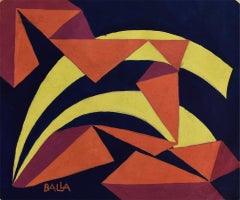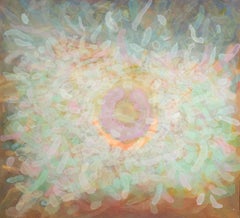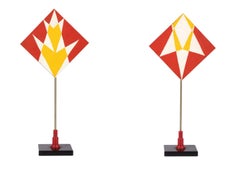Giacomo Balla Paintings
Giacomo Balla was born in Turin in 1871. Since he was a young boy, when he began to attend the Accademia Albertina, he dedicated his studies to the violin and painting. His first artistic accomplishment dates back to 1894, a self-portrait. In 1895, Balla moved to Rome with his mother and then in 1900, he moved to Paris for several months. His early years as a painter indicate an interest in the divisionist paintings of Giuseppe Pellizza da Volpedo and Giovanni Segantini, Impressionism and French Post-Impressionism. In 1910, together with his pupils Gino Severini and Umberto Boccioni, he signed the Manifesto of the Futurist Painters. It is in 1912, with works of art such as the famous Dynamism of a Dog on a Leash, that Balla’s art begins to show clear futuristic characteristics, demonstrating a special focus for the objective analysis of detail. Also in 1912, Balla made a provocative gesture with which he auctioned off all of his artwork and declared himself dead, still famous, the phrase pronounced on this occasion, “Balla is dead. Here are sold the works of art of the late Balla,” that marks the clear intention of the artist to deny himself and provoke the public, pushing him towards a reexamination of the values of art. Between the end of 1912 and 1914, the artist painted the Iridescent Compenetration, paintings in which the abstractionism of the composition and the geometry of the shapes prevail. In 1915, together with Fortunato Depero, he signed the Manifesto of the Futurist Reconstruction of the Universe. Towards the end of the Thirties, Balla’s futurist production was always more sporadic; the artist gradually returned to a more figurative painting. During his last years, Balla painted according to a realistic naturalism, that however, even if occasional, he had never completely abandoned.
1920s Giacomo Balla Paintings
Tempera
1940s Modern Giacomo Balla Paintings
Oil, Wood Panel
1880s Victorian Giacomo Balla Paintings
Wood Panel, Oil
2010s Abstract Giacomo Balla Paintings
Canvas, Acrylic, Tempera, Wood Panel
2010s Contemporary Giacomo Balla Paintings
Wood Panel, Oil
1650s Dutch School Giacomo Balla Paintings
Wood Panel, Oil
1940s American Modern Giacomo Balla Paintings
Egg Tempera, Board
1960s Abstract Expressionist Giacomo Balla Paintings
Fiberglass, Egg Tempera
1940s Modern Giacomo Balla Paintings
Masonite, Oil, Tempera
Early 2000s Contemporary Giacomo Balla Paintings
Oil, Wood Panel
1680s Flemish School Giacomo Balla Paintings
Wood Panel, Oil
1940s American Modern Giacomo Balla Paintings
Masonite, Oil, Tempera
1940s American Modern Giacomo Balla Paintings
Masonite, Oil, Tempera
2010s Abstract Giacomo Balla Paintings
Canvas, Egg Tempera
1930s Futurist Giacomo Balla Paintings
Tempera
1930s Futurist Giacomo Balla Paintings
Tempera
1930s Futurist Giacomo Balla Paintings
Tempera
1930s Futurist Giacomo Balla Paintings
Tempera
1930s Futurist Giacomo Balla Paintings
Tempera
1930s Futurist Giacomo Balla Paintings
Tempera
1930s Futurist Giacomo Balla Paintings
Tempera





